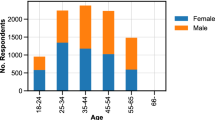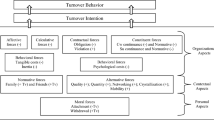Abstract
Employee turnover has attracted much publicity in Singapore. This research is concerned with (i) building a behavioural model consistent with prior research findings in this area and (ii) testing the model for explanatory power. The research was conducted in a large organisation with 300 subjects taking part in the survey. The model uses behavioural variables: seven variables of personal characteristics, and five factors in the Michigan Job Description Index. The dependent variable is the subject's score, on an interval scale, of intention to leave, which is a proxy for turnover. The findings of this research suggest that the model is able to explain a substantial portion of the variability of turnover intention with R2 at about 35 percent and a significant F-value.
Similar content being viewed by others
References
Ajzen, I., and M. Fishbein, “Attitude — Behaviour Relations: A Theoretical Analysis and Review of Empirical Research”Pyschological Bulletin 1977, 84, pp. 888–918.
Bartholomew, “The Statistical Approach to Manpower Planning”The Statistican 1971, 20, pp. 3–26.
Blood M., “Work Values and Job Satisfaction”, inJournal of Applied Psychology 1969, pp. 456–459.
Bohrnstedt, G., and M. Carter, “Robustness in Regression Analysis” Costner, II. (ED.),Sociological Methodology San Francisco: Josey Bass, 1971.
Chelora R. and J. L. Farr, “Absenteeism, Job involvement and Job Satisfaction in an organisational setting,”Journal of Psychology, 1980, pp. 469–475.
Dunham R.B., F.J. Smith, and R.S., Blackburn, “Validation of the Index of Organizational Reactions with JDI, the MSSQ, and Faces Scales” inAcademy of Management Journal 1977, Vol 20 pp. 420–432.
Ekpo-Ufot, A., “A Self-Perceived Abilities Relevant in The Task (SPART): A Potential Predictor of Labor Turnover In An Industrial Work Setting”Personnel Psychology 1976, 29, pp. 405–416.
Federico, J.M., P. Federico, & G.W., Lundquist, “Predicting Women's Turnover As a Function of Extent of Met Salary Expectations and Biodemographic Data,”Personnel Psychology 1976. 29, pp. 559–566.
Graen, G. and S. Ginshburgh, “Job Resignation As A Function of Role Orientation and Leader Acceptance: A Longitudinal Investigation of Organization Assimilation,”Organizational Behaviour and Human Performance 1977, 19, pp. 1–17.
Hulin, C.L., “Effects of Changes in Job-Satisfaction Levels on Employee Turnover,”Journal of Applied Psychology 1968, 52, pp. 122–126.
Kim, J.O., “Multivariate Analysis of Ordinal Variables,”American Journal of Sociology 1975, 88, pp. 261–98.
Knowles, M.C., “Personal and Job Factors Affecting Labour Turnover,”Personnel Practice Bulletin 1964, 20, September, pp. 13–18.
Knowles, M.C., “The Impact of Management Decisions on Labour Turnover,”Personnel Practice Bulletin 1965, 21, December, pp. 42–48.
McNichols C.W., “A Validation of Hoppock's Job Satisfaction Measure”Academy of Management Journal, 1978 pp. 737–742.
March, J.G., and H.A. Simon,Organizations New York: Wiley, 1958.
Martin, T.N, “Modelling The Turnover Process,”Journal of Management Studies, 1980, Oct, Vol 17.
Marsh, R., and H. Mannari, “Organizational Commitment and Turnover: A Predictive Study,”Administrative Science Quarterly 1977, 22, pp. 57–75.
Mobely, W.H., S.O. Horner, and A.T. Hollingsworth, “An Evaluation of precursors of Hospital Employee Turnover,”Journal of Applied Psychology 1978, 63, pp. 408–414.
Moffatt, G.W.B., and K. Hill, “Labour Turnover in Australia — A Review of Research, Part I,”Personnel Practice Bulletin 1970, 26, pp. 142–149.
Newman, J.E., “Predicting Absenteeism and Turnover: A Field Comparison of Fishbein's Model and Traditional Job Attitude Measures,”Journal of Applied Psychology 1974, 59, pp. 610–615.
O'Reilley, C.A., and K.H. Roberts, “Job Satisfaction Among Whites and Non-whites: A Cross-cultural Approach,”Journal of Applied Psychology, 1980, pp. 467–473.
Steers, R.M., “Antecedents and Outcomes of Organizational Commitment,”Administrative Science Quarterly 1977, 22, pp. 46–56.
Singapore Productivity News, National Productivity Board, October 1981.
Waters, L.K., D. Roach, and C.W. Waters, “Estimate of Future Tenure, Satisfaction, and Biographicla Variables As Predictors of Termination,”Personnel Psychology 1976, 29, pp. 57–60.
Author information
Authors and Affiliations
Additional information
The author acknowledges the helpful comments of Associate Professor Joseph Putti and the research assistance of Mr Gilbert Tan.
Rights and permissions
About this article
Cite this article
Ariff, M. A behavioural proxy model for employee turnover: Results from a Singapore study. Asia Pacific J Manage 5, 197–206 (1988). https://doi.org/10.1007/BF01733154
Issue Date:
DOI: https://doi.org/10.1007/BF01733154




